
The Curculionidae are the family of the "true" weevils. They are one of the largest animal families, with 6,800 genera and 83,000 species described worldwide. They are the sister group to the subfamily Brentidae

The boll weevil is a beetle that feeds on cotton buds and flowers. Thought to be native to Central Mexico, it migrated into the United States from Mexico in the late 19th century and had infested all U.S. cotton-growing areas by the 1920s, devastating the industry and the people working in the American South. During the late 20th century, it became a serious pest in South America as well. Since 1978, the Boll Weevil Eradication Program in the U.S. allowed full-scale cultivation to resume in many regions.
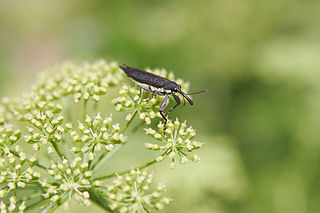
Weevils are beetles belonging to the superfamily Curculionoidea, known for their elongated snouts. They are usually small, less than 6 mm in length, and herbivorous. About 97,000 species of weevils are known. They belong to several families, with most of them in the family Curculionidae. Some other beetles, although not closely related, bear the name "weevil", such as the biscuit weevil, which belongs to the family Ptinidae.
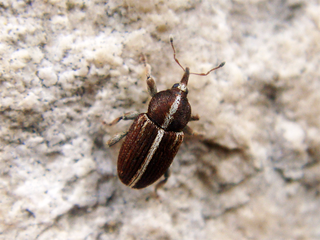
The beetle subfamily Curculioninae is part of the weevil family Curculionidae. It contains over 23,500 described species in 2,200 genera, and is therefore the largest weevil subfamily. Given that the beetle order (Coleoptera) contains about one-quarter of all known organisms, the Curculioninae represent one of the – if not the – most successful radiations of terrestrial Metazoa.
Caridae is a small Gondwanan family of weevils. They are considered part of the primitive weevil group, because they have straight rather than geniculate (elbowed) antennae. The insertion of the antennae on the rostrum cannot be seen from above. Caridae also lack spiracles on abdominal tergites 6 and 7. The prothorax lacks lateral carinae. It has been suggested that the fossil weevil Eccoptarthrus belongs in this family, which would result in a change in the family name ; this proposal has been rejected by most coleopterists (e.g.)
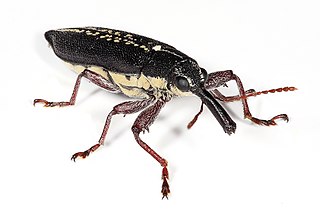
Belidae is a family of weevils, called belids or primitive weevils because they have straight antennae, unlike the "true weevils" or Curculionidae which have geniculate (elbowed) antennae. They are sometimes known as "cycad weevils", but this properly refers to a few species from the genera Parallocorynus and Rhopalotria.

Brentidae is a cosmopolitan family of primarily xylophagous beetles also known as straight-snouted weevils. The concept of this family has been recently expanded with the inclusion of three groups formerly placed in the Curculionidae; the subfamilies Apioninae, Cyladinae, and Nanophyinae, as well as the Ithycerinae, previously considered a separate family. They are most diverse in the tropics, but occur throughout the temperate regions of the world. They are among the families of weevils that have non-elbowed antennae, and tend to be elongate and flattened, though there are numerous exceptions.

The Attelabidae is a widespread family of weevils. They are among the primitive weevils, because of their straight antennae, which are inserted near the base of the rostrum. The prothorax is much narrower than the base of the elytra on the abdomen. Attelabidae and the related family Rhynchitidae are known commonly as the leaf-rolling weevils. Rhynchitidae may be treated as subfamily Rhynchitinae of the Attelabidae.
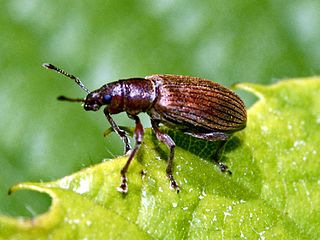
Polydrusus is a genus of weevils containing dozens of species, some of which are commonly found in Europe and northeastern North America. They are easily confused with Phyllobius, but are not as closely related as they seem at first glance.

The Entiminae are a large subfamily in the weevil family Curculionidae, containing most of the short-nosed weevils, including such genera as Otiorhynchus, Phyllobius, and Sitona. Some of these weevils are notorious pests of major economic importance.

Bin Weevils was a British MMORPG involving a virtual world containing a range of online games and activities.

Polydrusus impar is a species of weevils belonging to the family Curculionidae.

Polydrusus cervinus is a species of weevil native to Europe.

Polydrusus pterygomalis is a species of weevil native to Europe.
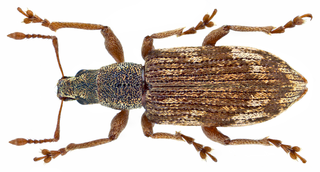
Polydrusus tereticollis is a species of weevil native to Europe.
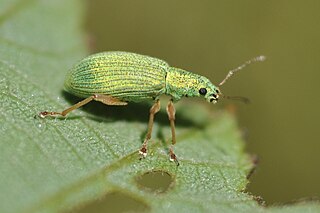
Polydrusus impressifrons, known generally as the pale green weevil or leaf weevil, is a species of broad-nosed weevil in the beetle family Curculionidae. It is found in North America & South Asia
Polydrusus hassayampus is a species of broad-nosed weevil in the beetle family Curculionidae. It is found in North America.
Polydrusus ochreus is a species of broad-nosed weevil in the beetle family Curculionidae. It is found in North America.
Polydrusus americanus is a species of broad-nosed weevil in the beetle family Curculionidae. It is found in North America.














